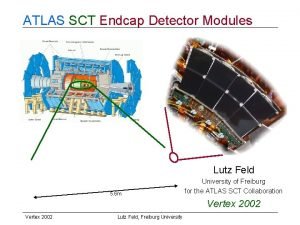ATLAS SCT EndCap Integration Reception ATLAS SCT EndCap

- Slides: 1

ATLAS SCT End-Cap Integration Reception ATLAS SCT End-Cap C arrived from the UK at the CERN SR 1 surface building facility on February 23 rd, 2006. The University of Manchester SCT team had spent many months preparing the end-cap clean area there, facilitating a smooth start to the CERN based operations. An initial period of reception testing was undertaken to verify that no damage had occurred during the transport, using an SCTRODDAQ system capable of reading out up to 144 modules. Clockwise from bottom left: ●SCT End-Cap C inside its thermal test box (panels removed) ready for testing. The temporary patch panels connecting to the Manchester-built cable support structure are seen in the right of the picture ●Arrival of SCT End-Cap C at CERN SR 1 ●Performing the disk alignment survey; inset shows the view through disks nine to seven, focused on the target of disk six. The reception testing phase also included a survey of the disk positions. This used a pair of telescopes to define two lines of sight, passing through circular targets of decreasing size through the nine disks. The Manchester group is coordinating the overall SCT end-cap alignment. Final Assembly End-Cap C has been positioned over the cantilever stand, ready for the addition of thermal enclosure, prior to integration with the TRT. The weight of the cylinder plus services must now be carefully transferred to the stand. Once the necessary support tooling is added, the remaining temporary support framework can be removed. The manufacture of the parts required to complete the end-cap, such as the inner and outer thermal enclosures, the front and rear carbon fibre supports, together with their associated custom tooling, has been spread across several sites. The final assembly sequence now relies on a specialised, visiting workforce from the SCT institutions. The permanent Manchester presence at CERN is ensuring a smooth progression from one stage to the next. Integration Above: Schematic of end-cap on temporary frame before addition of thermal enclosure (left) and when supported from cantilever inside thermal enclosure (right) Left: SCT End-Cap C now moved over the cantilever stand. Parallel assembly work on End-Cap A, which arrived from Nikhef on April 20 th, will soon begin adjacent to End-Cap C. Space management within SR 1 is therefore an important consideration, to avoid conflicts between delicate operations and ensure the safety of both the personnel and the detectors. for example from electrostatic discharge. Once thermal enclosure is completed and its gas tightness verified, the end-cap will undergo further testing to measure its noise performance inside its final environment. This will use a modified version of the test setup employed during the reception testing phase, prepared by Manchester physicists and technicians. Integration with the TRT end-cap will be achieved by sliding the TRT, supported on rails inside a trolley, over the SCT end-cap on the cantilever. The weight of the SCT is then transferred to the rails of the trolley. A final survey step will measure the relative positions of the two detectors. The completed ID end-cap will subsequently be installed in the SR 1 Test Area for combined testing, prior to installation in the ATLAS cavern. Above: Rails on the floor supporting the Inner Detector (ID) trolley will be aligned parallel to the envelope of the SCT, with wires passing through the 5 mm radial clearance then aligning the two detectors. Above right: Trial installation, load test and preliminary alignment of the floor rails and ID trolley. Note the rails inside the trolley to support the two detectors. Background: view through the support cylinder of the nine disks of SCT End-Cap C 25 th April 2006

